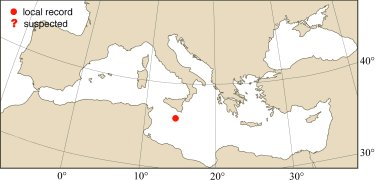|
Meristic formula |
||
|
SHORT
DESCRIPTION
Color : upper part of body silvery bluish-gray becoming silvery-white on the belly.
Common size : 10-30 cm (max. 36 cm). |
DISTINGUISHING CHARACTERISTICS Other carangids: body not deep, their depth more than 2.4 times in fork length.
BIOLOGY / ECOLOGY
Habitat : usually near the bottom in coastal waters to depth of 100 m. |
|
1st
MEDITERRANEAN RECORD
|

|
|
DISTRIBUTION
|
ESTABLISHMENT SUCCESS
|
|
|
MODE OF
INTRODUCTION |
IMPORTANCE TO
HUMANS |
|
KEY REFERENCES
|
|
|